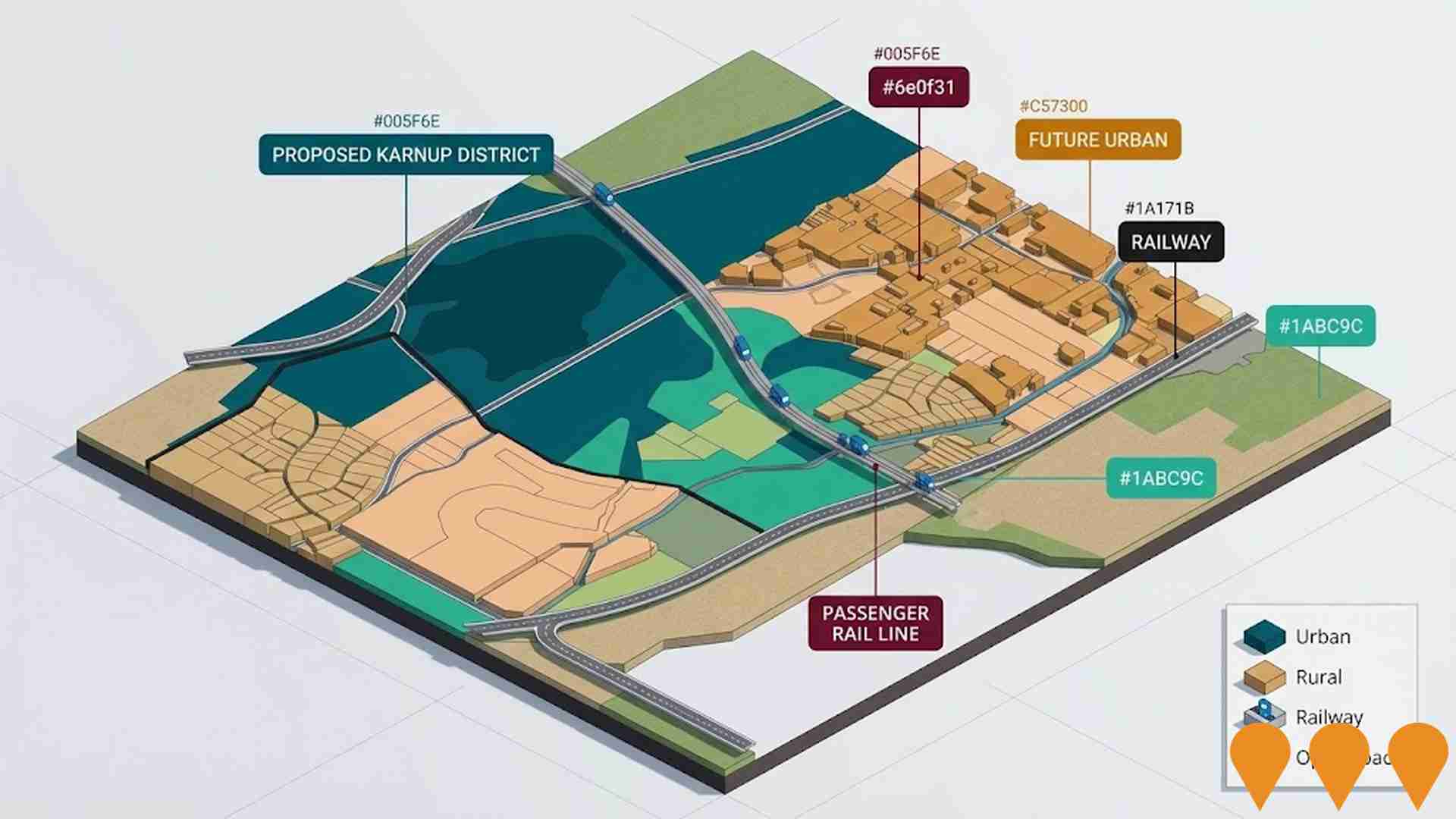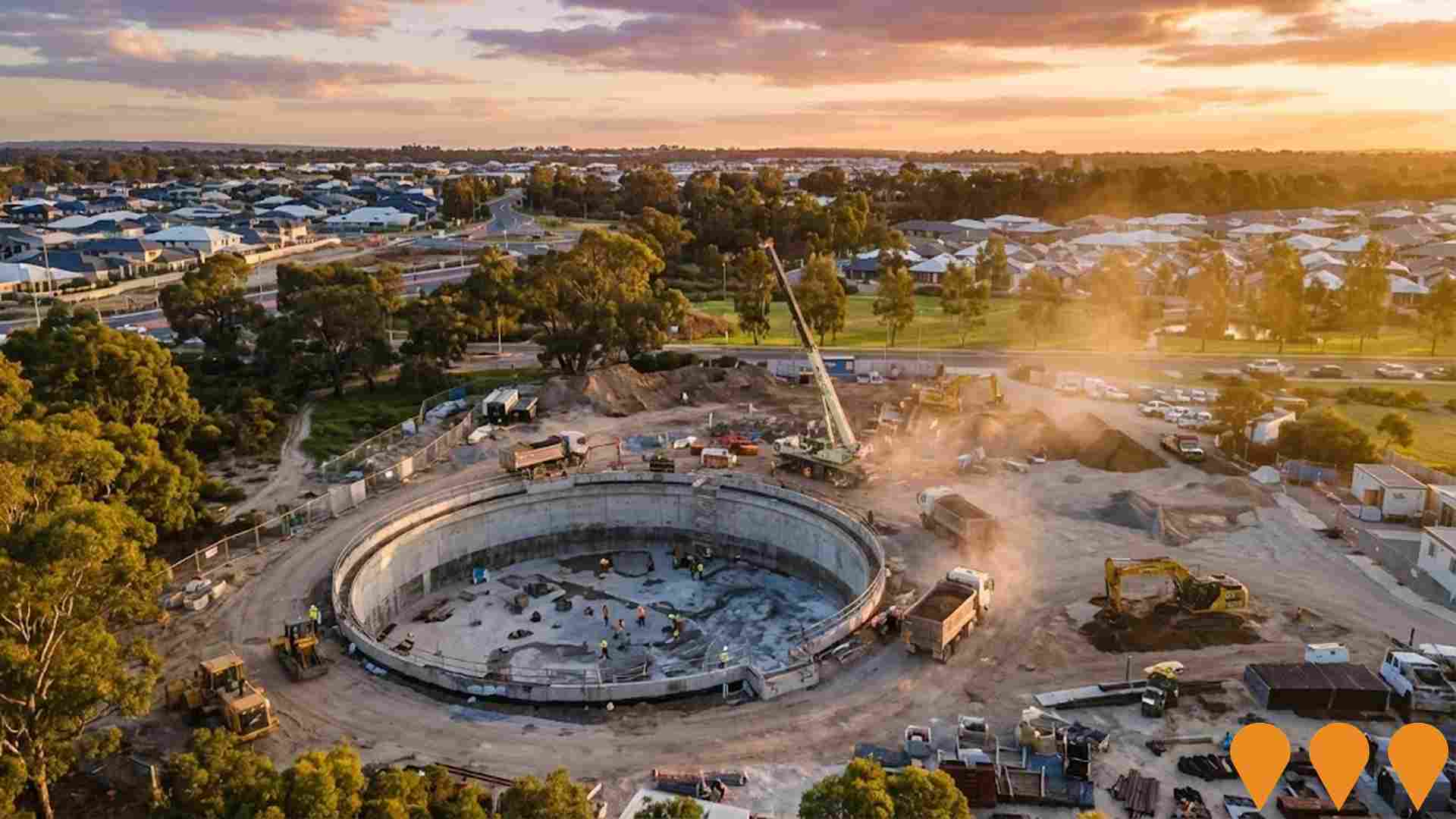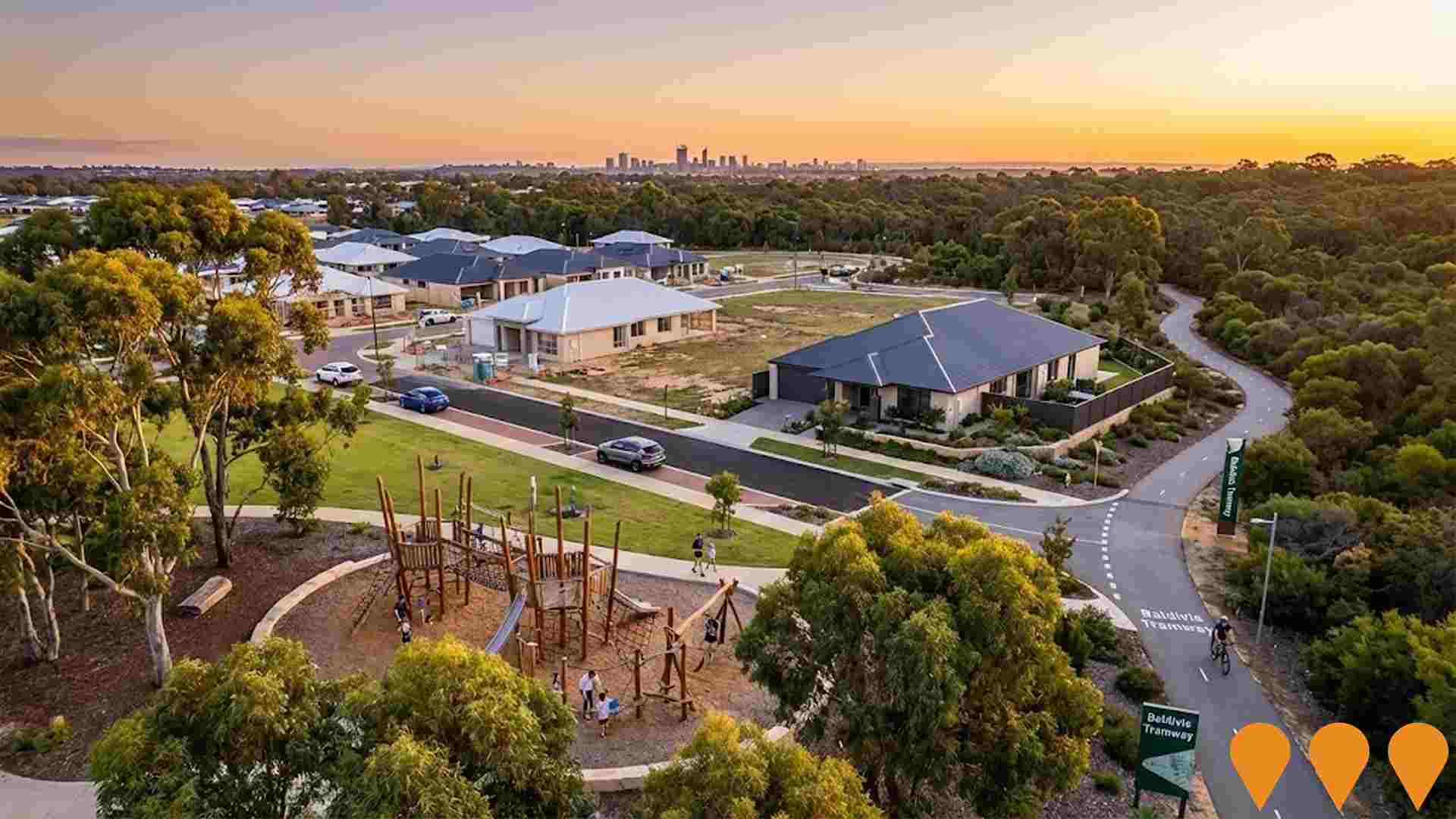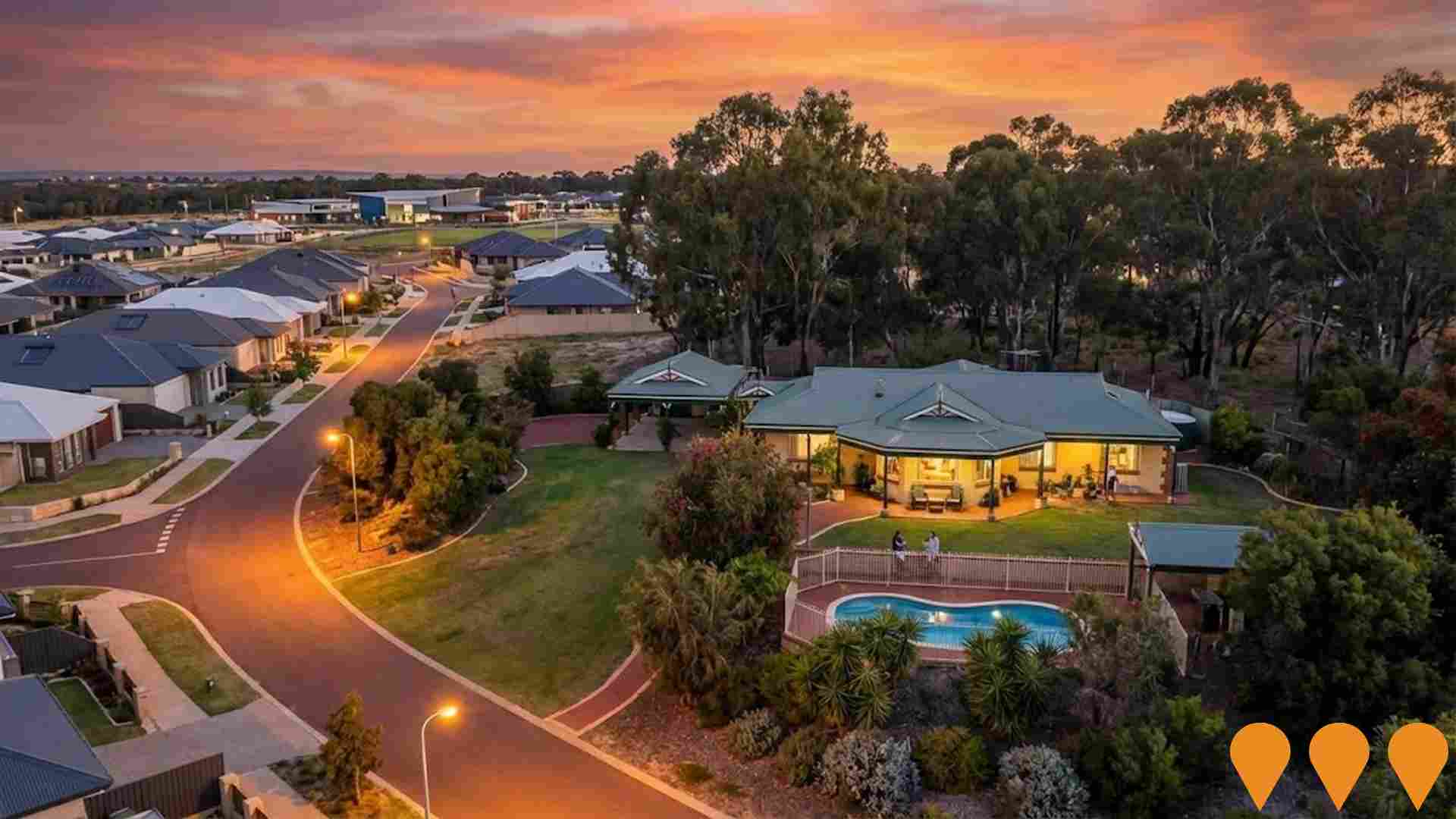Chart Color Schemes
est. as @ -- *
ABS ERP | -- people | --
2021 Census | -- people
Sales Activity
Curious about local property values? Filter the chart to assess the volume and appreciation (including resales) trends and regional comparisons, or scroll to the map below view this information at an individual property level.
Find a Recent Sale
Sales Detail
Population
Baldivis - South lies within the top 10% of areas nationally in terms of population growth performance according to AreaSearch analysis of short and medium-term trends
Baldivis - South's population is approximately 32,683 as of August 2025. This represents an increase of 6,637 people since the 2021 Census, which reported a population of 26,046. The growth from June 2024 to August 2025 is inferred from the estimated resident population of 30,259 and an additional 1,440 validated new addresses since the Census date. This results in a population density ratio of 1,089 persons per square kilometer, similar to averages seen across locations assessed by AreaSearch. Baldivis - South's growth rate of 25.5% since the 2021 census exceeds both the national average (8.6%) and the state average, positioning it as a growth leader in the region. Interstate migration contributed approximately 35.8% of overall population gains during recent periods, with all drivers including natural growth and overseas migration being positive factors.
AreaSearch is adopting ABS/Geoscience Australia projections for each SA2 area, released in 2024 with a base year of 2022. For areas not covered by this data, AreaSearch uses growth rates by age cohort provided by the ABS in its latest Greater Capital Region projections (released in 2023, based on 2022 data). According to population projections, Baldivis - South is forecasted to experience significant population growth, with an increase of 10,475 persons expected by 2041, reflecting a total increase of 24.6% over the 17-year period.
Frequently Asked Questions - Population
Development
The level of residential development activity in Baldivis - South was found to be higher than 90% of real estate markets across the country
Baldivis - South has seen approximately 368 dwelling approvals annually. Over the past five financial years, from FY21 to FY25, around 1,842 homes were approved, with an additional 143 approved in FY26 so far. Each year, an average of 2.3 new residents per dwelling has been recorded over these five years, indicating strong demand that supports property values.
The average expected construction cost value for new homes is $361,000, reflecting more affordable housing options compared to regional norms. This financial year, $948,000 in commercial development approvals have been recorded, suggesting a predominantly residential focus. Compared to Greater Perth, Baldivis - South has experienced elevated construction activity, with 50.0% above the regional average per person over the past five years. This area maintains good buyer choice while supporting existing property values, and developer confidence in the location is strong based on national comparisons.
New development consists of 97.0% standalone homes and 3.0% attached dwellings, sustaining the area's suburban identity with a concentration of family homes suited to buyers seeking space. With approximately 63 people per approval, Baldivis - South reflects a developing area. Future projections indicate that Baldivis - South will add around 8,051 residents by 2041. At current development rates, new housing supply is expected to comfortably meet demand, providing good conditions for buyers and potentially supporting growth beyond current population projections.
Frequently Asked Questions - Development
Infrastructure
Baldivis - South has emerging levels of nearby infrastructure activity, ranking in the 33rdth percentile nationally
Changes to local infrastructure significantly influence an area's performance. AreaSearch has identified 16 projects likely to impact the area. Key projects include Baldivis Parks, Millars Landing, Baldivis District Sporting Complex, and Karnup District Structure Plan. The following list details those most relevant.
Professional plan users can use the search below to filter and access additional projects.
INFRASTRUCTURE SEARCH
 Denotes AI-based impression for illustrative purposes only, not to be taken as definitive under any circumstances. Please follow links and conduct other investigations from the project's source for actual imagery. Developers and project owners wishing us to use original imagery please Contact Us and we will do so.
Denotes AI-based impression for illustrative purposes only, not to be taken as definitive under any circumstances. Please follow links and conduct other investigations from the project's source for actual imagery. Developers and project owners wishing us to use original imagery please Contact Us and we will do so.
Frequently Asked Questions - Infrastructure
North East Baldivis District Structure Plan - Precinct 1 (MRS Amendment 1427/57)
Major rezoning of approximately 129 hectares from Rural to Urban Deferred under Metropolitan Region Scheme Amendment 1427/57 to enable future urban development including residential estates, public open space and supporting infrastructure in North East Baldivis. The Western Australian Planning Commission initiated and finalised the amendment. Gazetted and effective from 13 May 2025.

The Edge Baldivis
The Edge Baldivis is a completed residential land development comprising 368 lots in Perth's southern corridor. The estate features beautiful retained bushland, community parks, walking trails, sports ovals, public art installations, and the purpose-built Sheoak Grove Primary School. Located just 800 metres from Baldivis Shopping Centre with easy freeway access, the development offers a family-friendly community environment with modern amenities and strong community spirit.

Baldivis District Sporting Complex
The Baldivis District Sporting Complex is a major regional multipurpose sport and community facility developed by the City of Rockingham. Stage 1 (indoor recreation centre with 4 courts, district pavilion, playing fields and associated infrastructure) opened in March 2023. The final stage, currently under construction, includes 8 outdoor netball courts, 8 tennis courts, additional changerooms, and an outdoor recreation space featuring a skate park and nature play area. Completion of the entire facility is scheduled for late 2025.

Stockland Baldivis Shopping Centre Expansion
Completed $116 million redevelopment and expansion of Stockland Baldivis Shopping Centre, expanding to approximately 28,000 sqm. Features full-line ALDI, Coles, Woolworths, Kmart, four mini-majors, over 70 specialty stores, and a main street restaurant precinct with over 1,400 parking spaces. Created 800 permanent retail jobs.

One71 Baldivis
One71 Baldivis is a sold-out masterplanned residential community of 411 lots across 30 hectares, featuring a central pump park with BBQ facilities, playgrounds and open spaces. The development includes the new Sheoak Grove Primary School and offers house and land packages designed for family lifestyles in Perth's southern suburbs.

Baldivis Parks
Master-planned residential community in Baldivis featuring parks, recreational facilities, and family-friendly neighborhoods with modern infrastructure and amenities.

Karnup District Structure Plan
Comprehensive planning framework for the future development of the Karnup district, establishing guidelines for urban growth, infrastructure, and community facilities.

Baldivis Wastewater Upgrades
Upgrade to the wastewater infrastructure in Baldivis to support the growing community and future land development. The project includes a new below ground wastewater pump station, overflow storage, and two short sections of wastewater pipeline.

Employment
Employment conditions in Baldivis - South demonstrate strong performance, ranking among the top 35% of areas assessed nationally
Baldivis - South has a balanced workforce with white and blue collar jobs. Its unemployment rate is 3.4%, lower than Greater Perth's 3.9%.
Employment growth over the past year was estimated at 4.8%. As of June 2025, 17,198 residents are employed, with an unemployment rate of 0.5% below Greater Perth's rate. Workforce participation is higher at 71.2%. Key industries include health care & social assistance, retail trade, and construction.
Mining has a significant share of employment at 1.3 times the regional level. However, professional & technical services employ only 5.0%, lower than Greater Perth's 8.2%. Employment opportunities locally may be limited as indicated by Census data comparison. In the year to June 2025, employment levels increased by 4.8% and labour force by 5.8%, leading to an unemployment rise of 0.9 percentage points. In contrast, Greater Perth had employment growth of 3.7% and labour force growth of 3.8%, with a 0.1 percentage point rise in unemployment. Jobs and Skills Australia's national employment forecasts from May 2025 project overall growth of 6.6% over five years and 13.7% over ten years. Applying these projections to Baldivis - South's employment mix suggests local growth of approximately 5.9% over five years and 12.7% over ten years, though this is a simple extrapolation for illustrative purposes only.
Frequently Asked Questions - Employment
Income
Income metrics indicate excellent economic conditions, with the area achieving higher performance than 75% of national locations assessed by AreaSearch
As per AreaSearch's latest postcode level ATO data released for financial year 2022, Baldivis - South's median income among taxpayers is $63,140. The average income in the area is $75,189. Nationally, these figures are high, with Greater Perth having a median of $58,380 and an average of $78,020. Based on Wage Price Index growth of 14.2% since financial year 2022, current estimates for Baldivis - South would be approximately $72,106 (median) and $85,866 (average) as of September 2025. Census data reveals that incomes in Baldivis - South cluster around the 74th percentile nationally. In terms of income distribution, 37.9% of locals (12,386 people) fall into the $1,500 - 2,999 category, reflecting regional patterns where 32.0% similarly occupy this range. High housing costs consume 16.4% of income in Baldivis - South, but strong earnings place disposable income at the 75th percentile nationally. The area's SEIFA income ranking places it in the 5th decile.
Frequently Asked Questions - Income
Housing
Baldivis - South is characterized by a predominantly suburban housing profile, with ownership patterns similar to the broader region
Baldivis - South had 96.7% houses and 3.2% other dwellings in its dwelling structure at the latest Census, compared to Perth metro's 90.5% houses and 9.6% other dwellings. Home ownership was at 16.4% in Baldivis - South, with mortgaged dwellings at 61.3% and rented ones at 22.3%. The median monthly mortgage repayment was $1,915, higher than the Perth metro average of $1,733. The median weekly rent was $370, compared to Perth metro's $330. Nationally, Baldivis - South's mortgage repayments were higher at $1,915 against Australia's average of $1,863, while rents were lower at $370 compared to the national figure of $375.
Frequently Asked Questions - Housing
Household Composition
Baldivis - South features high concentrations of family households, with a higher-than-average median household size
Family households constitute 82.5% of all households, including 45.5% couples with children, 23.6% couples without children, and 12.7% single parent families. Non-family households comprise the remaining 17.5%, with lone person households at 15.2% and group households at 2.3%. The median household size is 3.0 people, larger than the Greater Perth average of 2.6.
Frequently Asked Questions - Households
Local Schools & Education
Educational attainment in Baldivis - South aligns closely with national averages, showing typical qualification patterns and performance metrics
The area's university qualification rate is 16.7%, significantly lower than Australia's average of 30.4%. This presents both a challenge and an opportunity for targeted educational initiatives. Bachelor degrees are the most common at 12.2%, followed by postgraduate qualifications (2.6%) and graduate diplomas (1.9%). Vocational credentials are prominent, with 45.5% of residents aged 15+ holding them - advanced diplomas (12.4%) and certificates (33.1%).
Educational participation is high at 35.3%, including 14.5% in primary, 10.2% in secondary, and 3.8% in tertiary education. Baldivis - South operates a robust network of 9 schools educating approximately 7,505 students, with typical Australian school conditions (ICSEA: 1004) and balanced educational opportunities. The schools include 5 primary, 2 secondary, and 2 K-12 schools, with capacity exceeding residential needs at 23.0 places per 100 residents compared to the regional average of 17.1, indicating it serves as an educational center for the broader region.
Frequently Asked Questions - Education
Schools Detail
Nearby Services & Amenities
Transport
Transport servicing is low compared to other areas nationally based on assessment of service frequency, route connectivity and accessibility
Baldivis - South has 114 active public transport stops. These are served by a mix of buses along six different routes. The total weekly passenger trips facilitated by these routes is 1,545.
The average distance from residents to the nearest stop is 242 meters. The service frequency across all routes averages 220 trips per day, which translates to about 13 weekly trips per individual stop.
Frequently Asked Questions - Transport
Transport Stops Detail
Health
Baldivis - South's residents are extremely healthy with younger cohorts in particular seeing very low prevalence of common health conditions
Analysis of health metrics shows strong performance throughout Baldivis - South, with younger cohorts seeing very low prevalence of common health conditions.
The rate of private health cover was found to be very high at approximately 57% of the total population (~18,661 people). The most common medical conditions in the area were mental health issues and asthma, impacting 8.9 and 8.1% of residents respectively. A total of 73.3% of residents declared themselves completely clear of medical ailments, compared to 68.5% across Greater Perth. As of February 2021, the area had 10.1% of residents aged 65 and over (3,297 people), which is lower than the 15.6% in Greater Perth.
Frequently Asked Questions - Health
Cultural Diversity
Baldivis - South was found to be more culturally diverse than the vast majority of local markets in Australia, upon assessment of a range of language and cultural background related metrics
Baldivis-South, surveyed from June 2016 to May 2017, had a higher cultural diversity than most local areas. It recorded 11.0% of its population speaking languages other than English at home and 33.7% born overseas. Christianity was the predominant religion, comprising 41.7%.
The category 'Other' was notably overrepresented in Baldivis-South with 1.2%, compared to 0.7% across Greater Perth. In terms of ancestry, the top groups were English (34.2%), Australian (24.3%), and Other (7.7%). Some ethnic groups had notable differences: Maori at 2.4% (vs regional 2.0%), South African at 1.7% (vs 1.1%), and New Zealand at 1.4% (vs 1.2%).
Frequently Asked Questions - Diversity
Age
Baldivis - South hosts a very young demographic, ranking in the bottom 10% of areas nationwide
Baldivis - South's median age is 32 years, which is materially younger than Greater Perth's average of 37 years and significantly lower than Australia's national average of 38 years. Compared to Greater Perth, Baldivis - South has a higher concentration of residents aged 5-14 (17.2%) but fewer residents aged 65-74 (5.6%). This concentration is well above the national average of 12.2%. Post-2021 Census data shows that the proportion of residents aged 15 to 24 has grown from 12.3% to 14.3%, while the proportion of residents aged 25 to 34 has declined from 15.5% to 12.8%. The proportion of residents aged 5 to 14 has also dropped from 18.6% to 17.2%. Demographic modeling suggests that Baldivis - South's age profile will evolve significantly by 2041, with the strongest projected growth in the 45 to 54 cohort (39%), adding 1,623 residents to reach a total of 5,745. Conversely, population declines are projected for the 5 to 14 and 35 to 44 cohorts.





